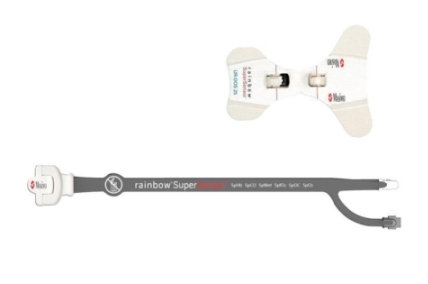Masimo today announced the CE Mark and debut of the new fractional arterial oxygen saturation, SpfO2™, parameter through the rainbow® Universal ReSposable SuperSensor™, the first noninvasive sensor to provide simultaneous monitoring of SpHb®, SpCO®, SpMet®, SpfO2, SpOC™, Perfusion Index, PVI®, and Measure-Through Motion and Low Perfusion SpO2 and pulse rate.
 The rainbow Universal ReSposable SuperSensor - with disposable optical sensor (Super UR-DOS - top) and reusable optical sensor (Super UR-ROS) - noninvasively measures oxygenation in the presence of dyshemoglobins, which may allow for better therapeutic decisions. (PRNewsFoto/Masimo)
The rainbow Universal ReSposable SuperSensor - with disposable optical sensor (Super UR-DOS - top) and reusable optical sensor (Super UR-ROS) - noninvasively measures oxygenation in the presence of dyshemoglobins, which may allow for better therapeutic decisions. (PRNewsFoto/Masimo)
Masimo will debut the SpfO2 and the rainbow® SuperSensor at the American Society of Anesthesiologists' 2012 Annual Meeting in Washington, D.C. , tomorrow.
Until now, pulse oximeters could only measure and display functional oxygen saturation (SpO2). So, when patients had elevated carboxyhemoglobin (from carbon monoxide poisoning) and/or elevated methemoglobin (negative reaction to more than 30 common drugs used in hospitals, like caines, nitrates, and Dapsone), the displayed functional oxygen saturation overestimated the actual oxygen saturation value.
Utilizing more than seven wavelengths of light and breakthrough signal processing, Masimo rainbow® Pulse CO-Oximeters™ can measure and display fractional arterial oxygen saturation (SpfO2). SpfO2 allows more precise arterial oxygenation assessment in patients with elevated dyshemoglobins, common throughout the hospital and pre-hospital setting, compared to functional oxygen saturation (SpO2).
SpfO2 may allow earlier interventions and more timely therapeutic decisions. For example, in a patient who is a smoker with an SpO2 of 98%, carboxyhemoglobin level of 12% and methemoglobin of 1%, if SpfO2 were available, it would be displayed at 85%. It is well accepted that clinicians would frequently make different diagnostic and therapeutic decisions at an oxygenation of 85% versus 98%.
"The new fractional arterial oxygenation measurement adds to the unprecedented noninvasive monitoring innovations Masimo has brought to clinicians, providing greater insight into the true state of their patients," said Masimo CEO and founder Joe Kiani . "SpfO2 will also be used with the noninvasive and continuous hemoglobin (SpHb) measurement, to assess the patient's true arterial oxygen content (SpOC) and should lead to better decisions about common therapies such as administering oxygen or red blood cell transfusions."
Both SpfO2 and the rainbow® SuperSensor are pending FDA 510(k) clearance.